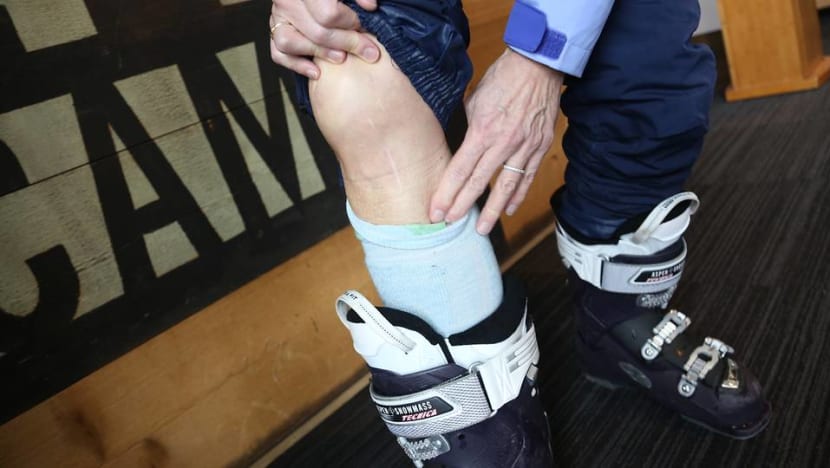Effectiveness of glucosamine questionable, but some patients do report benefits: Doctors
Doctors suggest that patients exercise regularly to maintain muscle strength and lose weight, and avoid high-impact activities to relieve joint pain.

Tens of millions of people over the age of 40 report that they at least occasionally hear noises in their knees, a condition that in medical circles goes by the ominous name of crepitus. (Photo: © 2017 The New York Times)
SINGAPORE: Researchers from the Netherlands recently found that glucosamine has "no more effect than a dummy pill” in treating knee or hip arthritis pain, but are doctors and patients here ditching the joint supplement?
Some doctors Channel NewsAsia spoke to said they have known for a long time that there is weak evidence surrounding the health benefits of glucosamine.
Dr Kevin Lee, founding partner of Pinnacle Orthopaedic Group said he personally does not prescribe glucosamine supplements and has not done so for the past six years.
“I know that a significant number of orthopaedic surgeons also do not do so as we have known for a while that there is no evidence in the literature that this particular supplement works any better than a placebo,” he said.
Consultant orthopaedic surgeon at Mount Alvernia Hospital, Dr Gowreeson Thevendran, said large-scale studies as early as 2006 demonstrated there was no significant advantage of glucosamine over placebo tablets or even commonly used anti-inflammatory medicine.
However, there seems to be a group of patients with osteoarthritis that report improvement in pain management and joint function, he said.
“While these improvements may not be permanent, it is reasonable to continue taking glucosamine in this group of patients as long as tangible benefits are seen,” he said.
Despite the lack of evidence surrounding the use of glucosamine to improve joint health, one person who has experienced pain relief from taking it is nurse Sutha Wasudevan.
Although the 30-year-old had her doubts, especially having worked in the orthopaedic ward and hearing patients complain about its ineffectiveness in decreasing their pain, she decided to give it a go one and a half years ago. She did not see a doctor.
“I was starting to do more high-impact exercises, and my knees were hurting. The pain always becomes worse with increased exertion. Usually, I would rest a lot between my exercise sessions, but I couldn’t afford to rest so much,” she said.
With her friend’s recommendation, she started taking glucosamine, and found that it helped with a “cracking” sound and pain in the knees, which she had been suffering from for more than five years.
She believes that it works for her as she found that when she did not take it for two weeks, the pain came back.
According to Euromonitor International, glucosamine was the fastest growing product in consumer health in Singapore last year.
Dr Anindita Santosa, an associate consultant from the rheumatology department in Changi General Hospital, said it may not be possible to convince patients already on glucosamine to stop taking the supplement, especially if they experienced reduced pain without any adverse effects.
“In such instances, where patients make informed decisions about continuing with glucosamine, doctors may continue prescribing it or advise the patient to purchase glucosamine as a retail item,” Dr Santosa said.

KNEE OSTEOARTHRITIS MORE COMMON THAN HIP OSTEOARTHRITIS IN SINGAPORE
Osteoarthritis is the most common form of arthritis here, Dr Santosa added.
While she said it is difficult to estimate the actual number of those affected by osteoarthritis, as those with mild osteoarthritis do not seek any medical opinion, in the 2007 National Health Surveillance Survey, about one in five Singaporeans aged 65 years-old and above reportedly had knee osteoarthritis.
Dr Thevendran said available data from the Ministry of Health shows that from 2004 to 2013, there were over 18,000 people above 50 years old who went for knee replacement surgery at public hospitals. This number was over 9,000 when it came to hip replacement surgery.
Over the same period, about 500 people aged between 30 and 49 went to public hospitals for knee replacement surgery, while about 400 had their hips replaced.
Dr Lee said that knee osteoarthritis is more common in the Asian population. while hip osteoarthritis is more common in the Western Caucasian population.
In those who are above 60, the cause is usually wear and tear, while in the younger group of patients who are 50 years old and below, they usually have sports-related injuries which have been left untreated leading to premature wear and tear. They may also be obese, leading to excessive load on the joints, Dr Lee added.
Doctors said that as the most important risk factors of hip and knee osteoarthritis are age and obesity, and with a rapidly ageing population and rise in prevalence of obesity, the number of individuals affected by osteoarthritis here is expected to rise.
MULTI-PRONGED APPROACH TO TREATMENT OF OSTEOARTHRITIS HERE: DOCTORS
Doctors also said glucosamine is usually just one aspect in the multi-faceted treatment of osteoarthritis.
While Dr Santosa said nothing can be done to reverse the damage caused by the degenerative process, she said there are measures that patients can take to slow the progression of the condition and mitigate pain.
Dr Thevendran concurs: “The non-operative treatment often requires a combination of regular exercise to maintain muscle strength and increase joint stability, weight loss, proper footwear and sometimes walking aids to reduce loading on the joints."
He added that selective use of anti-inflammatory medication and lifestyle modification to avoid activities like high-impact exercise would also help.
Consultant at the department of orthopaedic surgery at National University Hospital Mark Chong said conventional painkillers such as paracetamol can be useful as first-line treatment, and that this is usually supplemented by physiotherapy and supplements like non-steroidal cream or patches.

Failing such treatment, surgery such as joint replacement will be recommended based on the severity of condition, he added.
Dr Lee said that correction of any mechanical issues such as lower limb misalignment using braces or shoe modifications injections of a natural lubricant called hyaluronic acid into the joint are also treatment options.
Dr Santosa warned that there could be side effects from taking glucosamine, though these are not common. Some could experience abdominal discomfort, nausea and diarrhea, she said.
Recent reports also suggest that glucosamine may increase pressure in the eye in individuals with eye conditions like glaucoma, she added.
“Taking into account the potential adverse effects and the current lack of evidence on the benefits of glucosamine on pain control and improvement of physical function, I would suggest that patients discuss the risks and benefits of continuing on glucosamine if they are already on it,” Dr Santosa said.
Said Dr Thevendran: “In my opinion, a patient with symptomatic osteoarthritis could try glucosamine for three to six months. If there is noticeable improvement, there is little harm in continuing. Conversely, if there is no improvement, best to stop after six months.”












